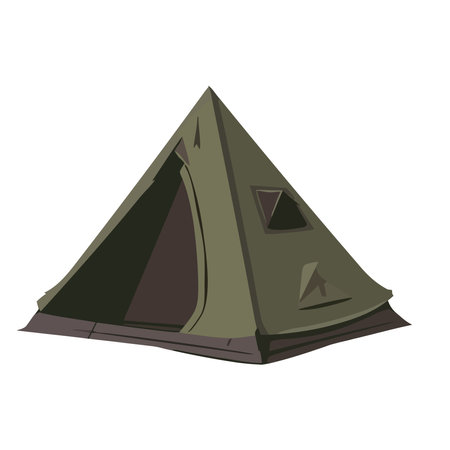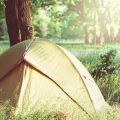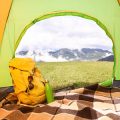1. Understanding the Challenges of High-Altitude Camping
Camping in the Sierra Nevada is a bucket-list adventure for many outdoor lovers, but heading into high-altitude areas comes with its own unique set of challenges. Before you hit the trail, its essential to understand how elevation impacts your body and your experience.
Altitude Sickness: What It Is and How It Affects You
One of the most common issues people face at higher elevations is altitude sickness, also known as Acute Mountain Sickness (AMS). This can happen when you go too high, too fast without giving your body enough time to adjust. Symptoms often include headache, nausea, dizziness, fatigue, and trouble sleeping. In severe cases, it can lead to life-threatening conditions like High Altitude Pulmonary Edema (HAPE) or High Altitude Cerebral Edema (HACE).
Common Symptoms of Altitude Sickness
| Symptom | Description |
|---|---|
| Headache | Dull or throbbing pain, usually first sign |
| Nausea | Feeling sick to your stomach, sometimes vomiting |
| Dizziness | Sensation of lightheadedness or loss of balance |
| Fatigue | Lack of energy even after resting |
| Trouble Sleeping | Poor sleep or waking up frequently during the night |
Weather Extremes in the Sierra Nevada
The Sierra Nevada is known for its unpredictable weather. Even in summer, temperatures can drop below freezing at night. Afternoon thunderstorms are common, especially in July and August. Strong winds and sudden snowfall can also occur at higher elevations—even when it’s warm down in the valley.
Typical Weather Conditions by Season
| Season | Daytime Temps | Nighttime Temps | Common Weather Events |
|---|---|---|---|
| Spring (Mar–May) | 40–60°F (4–15°C) | 20–35°F (-6–1°C) | Lingering snow, cold nights |
| Summer (Jun–Aug) | 60–80°F (15–27°C) | 30–50°F (-1–10°C) | A.M. sun, P.M. thunderstorms |
| Fall (Sep–Nov) | 45–65°F (7–18°C) | 25–40°F (-4–4°C) | Crisp air, early snowfall possible |
The Impact of Reduced Oxygen Levels
The higher you go, the thinner the air gets—and that means less oxygen with every breath. At elevations above 8,000 feet (about 2,400 meters), many people start noticing shortness of breath even during light activities like setting up camp or walking uphill.
Tips to Cope With Lower Oxygen Levels:
- Pace yourself—don’t rush hikes or campsite setup.
- Breathe deeply and steadily; avoid holding your breath during physical tasks.
- If possible, spend a night or two at mid-elevation before going higher to help your body acclimate.
- Avoid alcohol and heavy meals on your first day at altitude.
- If symptoms worsen, descend immediately.
The Sierra Nevada is stunning but requires respect for its environment—especially at elevation. Knowing what to expect helps you stay safe and enjoy every moment above the tree line.
2. Essential Gear for High-Altitude Conditions
Camping in the Sierra Nevada at high elevations means you’ll need to be prepared for rapidly changing weather, colder temperatures, and wildlife encounters. Having the right gear can make or break your trip. Heres a breakdown of the essential equipment youll want to bring.
Four-Season Tent
High-altitude environments can be harsh, even in summer. A four-season tent is built to handle strong winds, heavy snow, and freezing temperatures. Look for one with a sturdy pole structure and low-profile design to stand up against alpine conditions.
Cold-Weather Sleeping Bag
Nights can get very cold in the Sierra Nevada, especially above 8,000 feet. Choose a sleeping bag rated for at least 0°F to 20°F (-18°C to -6°C), depending on the time of year. Down-filled bags offer excellent warmth-to-weight ratio but remember they must stay dry.
Insulated Sleeping Pad
A good sleeping pad does more than just provide comfort—it also insulates you from the cold ground. Look for one with an R-value of 4 or higher for high-elevation camping.
Water Purification System
You won’t want to carry all your water with you, so having a reliable water purification method is essential. Glacier-fed streams may look clean but can contain harmful bacteria or protozoa like Giardia.
| Type | Pros | Cons |
|---|---|---|
| Water Filter Pump | Removes bacteria and protozoa quickly; great for groups | Can be bulky and requires effort to pump |
| Squeeze Filter | Lightweight and compact; easy to use solo | Slower flow rate; may clog over time |
| UV Purifier | Kills viruses; fast treatment time | Requires batteries; doesn’t remove particles |
| Chemical Tablets | Ultralight and effective against most pathogens | Takes longer (30 min+); may alter taste |
Bear-Safe Food Storage
The Sierra Nevada is black bear country, and food storage regulations are strictly enforced in many areas. You’ll need either a bear canister or an approved bear-resistant bag system like an Ursack.
Bear Canisters vs Ursacks:
| Storage Method | Advantages | Limitations |
|---|---|---|
| Bear Canister | Widely accepted by land agencies; durable protection | Bulky and heavy; takes up pack space |
| Ursack + Liner | Lighter weight; easier to pack into backpack | Some areas don’t accept as a legal storage method without approval |
Other Must-Haves for High Altitudes
- Trekking poles: Help maintain balance on steep or rocky trails.
- Sunscreen and lip balm: UV exposure increases with altitude—protect your skin.
- Layered clothing: Use moisture-wicking base layers, insulating mid-layers, and waterproof outer shells.
- Headlamp with extra batteries: Days are shorter in the mountains; always have light ready.
- Map and compass or GPS device: Cell service is unreliable—always have a backup navigation method.
Packing smartly ensures you’re ready for whatever the Sierra throws at you—from sudden temperature drops to curious bears. With the right gear, you’ll stay warm, safe, and comfortable while enjoying some of the most breathtaking wilderness America has to offer.
![]()
3. Nutrition and Hydration at Elevation
When camping in the Sierra Nevada at higher elevations, your body works harder than usual. The air is thinner, meaning there’s less oxygen, and you burn more calories just by doing everyday activities. That’s why it’s essential to adjust how you eat and drink while on your trip.
How Altitude Affects Your Body
At higher elevations—especially above 8,000 feet—you may notice changes like shortness of breath, faster heartbeat, reduced appetite, and increased urination. These are all normal responses as your body adjusts to lower oxygen levels. Because of this, staying fueled and hydrated becomes even more important.
Eating Right: Fuel for the Mountains
Your body needs more calories at altitude, even if youre not hiking hard every day. Focus on meals that are high in complex carbs and healthy fats to give you lasting energy. Heres a simple guide:
| Meal | What to Eat | Why It Helps |
|---|---|---|
| Breakfast | Oatmeal with nuts & dried fruit | Sustained energy from carbs and healthy fats |
| Lunch | Whole-grain wraps with nut butter or cheese | Easy-to-pack and calorie-dense |
| Dinner | Pasta or rice with protein (like tuna or beans) | Refuels muscles and boosts recovery |
| Snacks | Trail mix, granola bars, jerky | Quick calories to keep you going during hikes |
The Importance of Hydration
You lose water faster at elevation due to drier air and increased respiration. Even if you don’t feel sweaty, your body is still using up fluids. Dehydration can make altitude sickness worse, so drink more than you think you need—aim for at least 3-4 liters per day.
Tips for Staying Hydrated:
- Sip water regularly instead of waiting until youre thirsty.
- Add electrolyte tablets or powders to your water—these help replenish minerals lost through increased urination.
- If its cold, try warm drinks like herbal tea or broth to stay hydrated and comfortable.
Avoiding Common Pitfalls
A lot of campers experience reduced appetite at high elevation, but it’s important to eat even if youre not super hungry. Small, frequent meals work better than big ones. Also avoid alcohol—it dehydrates you quickly and can worsen altitude symptoms.
4. Acclimatization and Physical Preparation
If youre heading to the Sierra Nevada for a high-altitude camping adventure, its important to get your body ready before you go. The air gets thinner at higher elevations, which means theres less oxygen. This can lead to altitude sickness if youre not prepared. Here’s how you can physically condition yourself and acclimate properly once you arrive in the mountains.
Train Your Body Before the Trip
Start preparing at least 4–6 weeks before your trip. Focus on exercises that build endurance, strengthen your legs, and improve your cardiovascular health. You don’t need fancy equipment—just consistency and dedication.
Recommended Pre-Trip Exercises
| Exercise | Frequency | Why It Helps |
|---|---|---|
| Hiking with a backpack | 2–3 times per week | Builds stamina and mimics trail conditions |
| Stair climbing or hill sprints | 1–2 times per week | Improves leg strength and cardio fitness |
| Cycling or jogging | 3–4 times per week | Boosts overall endurance and lung capacity |
| Strength training (legs & core) | 2 times per week | Supports pack weight and balance on uneven terrain |
Give Yourself Time to Acclimate
Once you arrive in the Sierra Nevada, don’t rush into intense activity. Your body needs time to adjust to the elevation, especially if you’re camping above 8,000 feet.
Tips for Better Acclimatization
- Ascend gradually: If possible, spend a night at mid-elevation (around 6,000–7,000 feet) before heading higher.
- Stay hydrated: Drink plenty of water to help your body adjust more easily.
- Avoid alcohol and caffeine: These can dehydrate you and make symptoms worse.
- Listen to your body: If you feel dizzy, nauseous, or short of breath, take it easy and rest.
- “Climb high, sleep low”: Hike during the day to higher altitudes but return to a lower elevation to sleep if possible.
Mild Altitude Sickness Symptoms Can Include:
- Headache
- Nausea or loss of appetite
- Dizziness or fatigue
- Trouble sleeping
If symptoms persist or worsen, descend immediately and seek medical attention if needed. Preparing ahead of time and listening to your body are key to enjoying your high-altitude camping trip safely.
5. Leave No Trace and Local Regulations
When camping in the high-altitude areas of the Sierra Nevada, it’s essential to follow responsible camping practices that protect the environment and preserve the natural beauty for others to enjoy. Here are some key guidelines to help you stay respectful and compliant during your trip.
Respect Wildlife
Wild animals in the Sierra Nevada are part of what makes this region special. Always observe wildlife from a distance. Feeding animals, even unintentionally by leaving food out, can harm them and create dangerous situations for future campers. Use bear-proof containers for all food and scented items—this is not just a good idea, its often required in many parts of the Sierra.
Follow Campfire Rules
Fires are a serious risk in dry mountain environments. Depending on the season and location, campfires may be restricted or banned altogether. Always check current fire regulations with the local forest service or park office before your trip. If fires are allowed, use established fire rings only, keep fires small, and never leave one unattended. When youre done, make sure its fully out—cold to the touch.
Pack It In, Pack It Out
Everything you bring in should leave with you. Trash, leftover food, used hygiene products—all of it goes back into your pack. Even biodegradable items like orange peels or food scraps should be packed out; they don’t break down quickly in alpine environments and can attract wildlife.
Know Permit Requirements
Certain areas in the Sierra Nevada require wilderness permits for overnight stays, especially popular trails like those in Yosemite or Desolation Wilderness. These permits help limit impact on delicate ecosystems and ensure visitor safety. Check with the appropriate ranger district or recreation.gov to get permits ahead of time.
Common Permit Areas and Where to Apply
| Area | Permit Required? | Where to Get It |
|---|---|---|
| Yosemite National Park | Yes (overnight) | recreation.gov |
| Desolation Wilderness | Yes (overnight) | El Dorado National Forest Office / recreation.gov |
| Ansel Adams Wilderness | Yes (overnight) | Inyo National Forest Office / recreation.gov |
Stick to Durable Surfaces
When setting up camp or hiking off-trail, always stick to durable surfaces like rock, gravel, or established paths to prevent damaging fragile alpine vegetation. Avoid camping within 200 feet of lakes and streams to protect water sources.
The Leave No Trace Principles
The Leave No Trace Center for Outdoor Ethics promotes seven core principles that are especially important in sensitive environments like the Sierra Nevada:
- Plan ahead and prepare
- Travel and camp on durable surfaces
- Dispose of waste properly
- Leave what you find
- Minimize campfire impact
- Respect wildlife
- Be considerate of other visitors
If everyone follows these simple rules, we can help keep the Sierra wild and beautiful for generations to come.


